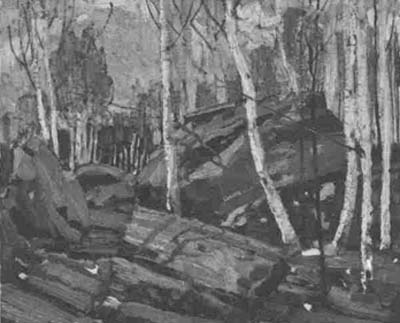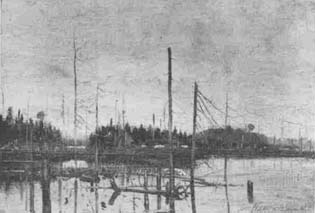
Bulletin 16, 1970
Home
Français
Introduction
History
Annual Index
Author &
Subject
Credits
Contact



Photographs
by Tom Thomson
by Dennis Reid, Curator of Post-Confederation Art
Pages 1 | 2
| 3 | 4 |
5 | 6
| 7 | 8
The relationship of Thomson's paintings to the camera image can be
seen in another way. Dr. MacCallum has reported that Thomson's
"one criticism of his own work was 'there is not enough
day-light in that'." (14) In his photographs, Thomson often sought
light, and its concomitant shadow, with a naïve directness. When
shot into the sun or into the brightest part of the sky, his photographs have little modulated tone. Some
of these such as photographs 25 and 26, achieve delicately elaborate silhouettes.
Number 26, particularly, brings immediately to mind his great
canvas Northern River, with its graceful looping
traceries. (15)
His less well-known The Silent Lake (fig. 3) exploits this
silhouetting device in a way that even seems to stress its
similarity to a photograph. The dominant sky becomes an uninhibited celebration of pure daylight.
Photographs are, of course, made with light. Photograph 40 is an
eloquent exposition of that fact. Light is filtered through a great
variety of leafy screens, bathes a hillside seen through the black
relief of a rough fence, and glares off facets of the irregular
boulder marking a Canoe Lake grave. We become intensely aware of
reading the forms, the masses in space, only as reflected light of
differing intensities. In his Northern River, the credibility
of the river seen through the black screen of trees is totally
dependent upon an ability to give a sense of space-forming day-light.
In his later sketches (see fig. 4), he developed this way of
seeing light as almost a sculpting device. The birch trees exist
only as the intense reflection of light on their white bark, the
rocks as various planes revealed by the play of filtered and
screened light. The very same eye was looking through the view-finder when photograph 40 was taken.
We have seen that, although Thomson himself appears not to have
considered these photographs seriously as art objects, they are,
nonetheless, intimately related to his creative vision. One
question still remains to be asked. Did Thomson ever use these
photographs as an aid in working through the problems raised by his
painting? Again there seems to be no evidence that he ever did. No
paintings at this time can convincingly be demonstrated to be in
any way based on a photograph. We can conjecture that photographs 25
and 26 had some bearing on his treatment of Northern River. But
this must remain conjecture. The only snapshots directly related to
a known painting are photographs 6 and 7. If they were taken while
Thomson was on his canoe trip with W. S. Broadhead in 1912, then the
sketch Drowned Lake (fig. 5) was painted on the same trip. A
comparison of the sketch with photograph 7, in particular, is not
unconvincing.
However, I have not published these photographs in order to search
out their historical significance. They are presented here as, in
themselves, worthy objects for examination and reflection. As a
consequence, the opportunity has arisen to consider their importance
in relation to Thomson's other activities, and to argue for their
acceptance and preservation as an integral part of his sustaining
vision.
Next Page | Pictures
1 to 7
1 | 2
| 3 | 4 |
5 | 6
| 7 | 8
Annual Index | Author & Subject | Credits | Contact
This digital collection
was produced under contract to Canada's Digital Collections program,
Industry Canada.
"Digital
Collections Program, Copyright
© National Gallery of
Canada 2001"